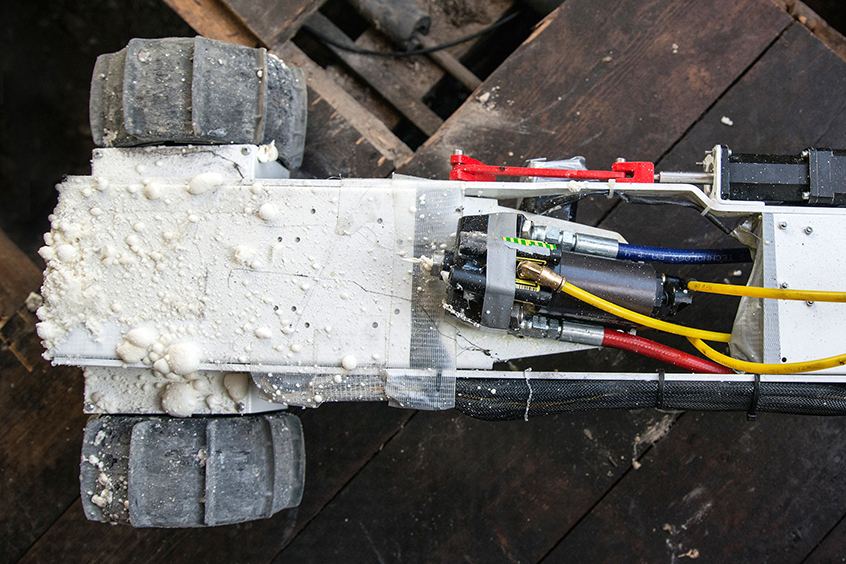Trials of an autonomous robot that crawls under the floorboards of old houses squirting insulation have shown that heat loss can be reduced by as much as 86%, the system’s developer has announced.
London-based start-up Q-Bot, developer of the scanning-and-squirting bot of the same name (pictured), told GCR that the system, which does away with the need to rip up floorboards, could save more energy than replacing single glazed windows with double glazing, and replacing a 15-year-old central-heating boiler with a brand new one.
"The trials showed what an impact the technology has – a massive impact on comfort," said Q-Bot managing director, Mathew Holloway. "The amount of heat lost through the floor is actually far greater than people might realise."
The Q-Bot is sent into the under-floor void through a hole drilled by a technician, or through a vent. It scans the area to build a picture of what’s there and then squirts insulation fed by an umbilical cord, sealing any cracks.
London’s Camden Borough Council and residential property manager CityWest Homes trialled the Q-Bot at two period properties – a 72 sq m ground floor flat, and a 69 sq m terraced house – last year.

The Q-Bot is sent into the under-floor void in older homes to scan the area and squirt insulation (Q-Bot)
In Camden heat-loss through the floor was cut by 78%, while cold air infiltration was eradicated, reducing infiltration into the house by over 60%, the test results showed.
In the CityWest trial the total heat loss through the floor was reduced by 86% and a 45% reduction in cold air infiltration was achieved despite the single-glazed sash windows the property had.
Cosy homes
"I am absolutely delighted," said one resident, whose comments Q-Bot recorded. "My flat has never been described as cosy before. It is warm, quieter and there are less cold draughts."
The results of the trials were released to GCR after Q-Bot came highly commended in this year’s International Innovation & Research Awards organised by the Chartered Institute of Building.
The judges were impressed, and believed the market for Q-Bot could be big.
"Q-Bot’s innovative robotic solution recognises the need for a non-intrusive method of improving under-floor insulation in existing properties," they said in their citation. "It is an exciting and innovative product which has great potential for improving the energy efficiency of the UK’s housing stock."

Engineer and entrepreneur Mathew Holloway, Q-Bot managing director since 2013 (Mathew Holloway)
Holloway, an engineer, entrepreneur and tutor at Imperial College London, joined architect Tom Lipinski at the new company in 2013. Q-Bot had earlier been started by Lipinski and Imperial College professor, Peter Childs.
They are now targeting owners of large pre-1919 property portfolios in the hope that their stealth-insulating method will appeal to landlords and tenants.
Holloway wouldn’t disclose the size of the company but insisted that it was in a high-growth stage and had deals now with Camden Council, CityWest Homes and Peabody, all sizeable London housing providers. A team of electrical, mechanical and software engineers was busy developing the technology, he said.
Q-Bot has won seed funding from the UK government’s Emerging Entrepreneurs Fund, its Technology Strategy Board, and from the EcoMachines Incubator Accelerator programme, but Holloway said real sales now contribute to Q-Bot’s revenue.
Ready for take-off?
Holloway believes the market will respond not just in the UK but in Northern Europe, too, where there is a large stock of homes with suspended timber floors needing insulation.
"We have backers who can scale up manufacture of the robots in a very large and quick way," he told GCR, "but we need to show that we have some traction that makes it worthwhile doing. So it is a bit of a chicken-and-egg situation, which many companies face.
"But we’re lucky to be working with councils and housing associations because they do plan ahead and are a bit more consistent in their thinking. We are already delivering and our delivery capability is scaling up all the time in response to customer demand."
As an entrepreneur – he was the driving force between the Cool-Phase low-energy ventilation system, which was later acquired by Monodraught – Holloway said things were a little different in the UK for start-ups, compared to the US.
"In the UK we’re slightly less gung-ho about things than maybe in the US, where you can have an idea and someone will throw $10m at it," he said. "You have to take things a bit further, push things a bit further but, if there is a strong potential, there is no reason it won’t take off, and there is a lot of support for start-up and early stage companies to grow in the UK."
Comments
Comments are closed.











A great idea which I applaud but air does keep timber dry so there is a possible limitation- There was a huge litigation claim in New Zealand when an insulation scheme went wrong in their timber houses. I have early foam insullation in my cavity walls which I know suffers from shrinkage cracks so i know my late 70’s house is now less energy efficient that it once was. I don’t know of a way of repair or reinsulating it. The foam when touched just turns to dust
Congratulations Mathew,
I have followed your career since you were involved with Artica as we where both involved with Phase Change Materials for building innovation, looking forward to seeing Q- bot in the near future.
Comment
Great idea Mathew! My only reservation would be if it prevented proper ventilation of the sub floor, thus encouraging the timber to rot? Time will tell!
Richard
I had the same thoughts as Richard Biggs, but coupled them with the problems of rewiring/alterations and replumbing if the cables and pipes are all enclosed in the sprayed insulation. There is also the parallel with sprayed roof insulation, this has been known to aggravate wood rot, and also when reroofing is finally required, all the slates/tiles are scrap. Apart from that – its a brilliant idea
The idea is great, but I agree with the other comments in relation to disturbing the existing services and air flow. From a practical perspective of existing homeowners, wouldn’t it be a better idea to utilise a thermal underlay rather than having to take up floorboards and cause potential on costs to the end user? I am aware that a number of multi-foil companies have a thermal underlay which offer a similar outcome in reduction of heat loss. With eternal walls being upgraded externally I can see the vision here but unless homeowners are prepared to renovate or renew flooring I cannot see how they would be drawn in to this unless its for free.
Fantastic display of innovation as pressure to improve the energy efficiency of historic buildings increases. However, the reduction in air flow will significantly increase the chances of rot and other timber defects. Could this turn into a rotten solution? (Excuse the pun).